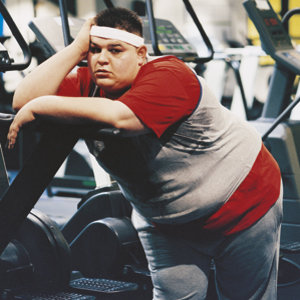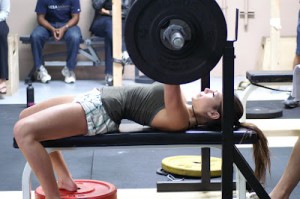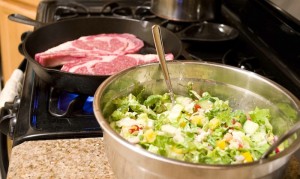I’d rather work smarter than work harder. Some people will say that that makes me lazy. Preposterous. No lazy man has ever devoted so much effort to applying so little effort.
I can go on forever about fat loss — tactics, training programs, eating strategies, and so forth. But, because everyone keeps asking for a short version, below is my super-secret primer for lazy fat loss.

Remember: This is a primer. And this primer is for the 90% of people in the middle of the bell curve. Do you have morbid obesity? Are you a guy or gal trying to shave the last 3 lbs of fat to get down to 5% or 12% bodyfat? If so, some of your tactics should be different. If you’re not dangerously obese or dangerously lean, you’re in the right place…
Without any further ado:
1) Weights over cardio
The bottom line is that cardio is lame. You burn calories while you’re doing it, but once you’re done, so is your calorie burn. Resistance and interval training help you burn calories at rest, which is how any smart-working lazy guy would want it. No, not because muscle burns more calories than fat (it does, but it’s really not significant); because intense resistance training and intense intervals set off EPOC (excess post-exercise oxygen consumption). EPOC means you burn more calories at rest. And for those who are counting, we burn most of our calories at rest. And fat is a primary fuel source when you’re at rest. I plan to burn more fat writing this than most people burn during a “cardio workout.”
If you’re working out fewer than 5 hours per week and you’re doing “cardio,” you’re doing it wrong.
2) Intensity is key
When I said “intense resistance training” I meant intensity in the technical sense: % of 1 rep-max (1RM = the most weight you can lift 1 time). Spend time in the 80%+ range. For most people, this means if you can do it more than 8 times, it’s too light. Logistically, it also means sprinting instead of jogging.
Lift heavy to get light.
3) Warm-up properly
A rough guide to warming-up: soft-tissue work (like foam rolling and lacrosse/tennis ball work), followed by mobility work, followed by activation work. This will keep you moving well, reduce risk of injury during your [now incredibly intense] workouts, and make you feel better before, during, and afterwards. A good warm-up’s main fat-loss benefits are in allowing you to accomplish more work (the physics version of work: Force x displacement) during a given workout, priming your nervous system for intensity, keeping you from getting derailed with injuries, and helping you recover better.
Which brings us to….
4) SLEEP!
Remember when I said you burn most of your calories at rest? Well, you really do a great job of resting while asleep. Sleeping longer (and better) aids you in burning calories, getting in intense workouts, living longer, having better sex, being smarter, and other things that cannot possibly be as important as fat-loss.
Oh, did I forget to mention that not getting enough sleep sets off a cascade of hormones that makes you a fat retaining machine? Get yourself a going to bed routine.
5) Meat and veggies
The food misinformation we’ve been fed (see what I did there?) is borderline criminal. Want to burn fat? Meat and veggies. That’s it. (Okay, okay, eggs, nuts, and cheeses can make the list). No grains. No potatoes. No calorie filled drinks (I’m looking at you, OJ). If you believe that animal fats and salt are bad for your health, but that grains are good I have a bridge to sell you. Also, I have a bunch of articles for you to read (bridge sold separately). You’re about to start eating a boatload of veggies at every meal, so don’t expect to be hungry. Being famished and lazy fat loss don’t work well together.
Remember all those grains you were eating? Well, they’re veggies now.
If you’re a vegetarian (and if you are, so help me, it better be for ethical reasons), you’ve got a much larger task in front of you. You will need more rigorous planning, portion control, and supplements. It’s just beyond the scope of this primer.
6) Post-Workout
Do not starve after your workout. While it may seem counterintuitive to eat directly after you burnt all those calories, it’s actually the ideal time. Remember, working out to burn calories is lame. Working out so that you can burn more calories while living is the lazy man’s way. Eat carbs and proteins directly after your [freakishly intense] workouts. Now is your chance to eat rice, potatoes, etc. Don’t get carried away. I didn’t say to eat a pizza. I DIDN’T SAY EAT A PIZZA. The carbs will help replenish the glycogen you depleted while working out and will be stored primarily as lean tissue rather than doing what they usually do: winding up as stuffing for your jeans.
7) Supplements
Luckily you’re eating lots of meat and veggies, so most of your nutritional needs are covered (unlike high grain diets that need to be fortified and enriched so that you don’t get weird diseases from your high grain diet. I know, I know, it sounds crazy to me too). I do have a couple of supplements for you, nevertheless:
Fish oil: It’s a reasonably priced way to get extra omega-3 fatty acids into your diet. Our modern diet is strangely low in these essential fats. Best food sources? Cold water fatty fish and grass-fed/grass-finished meats. Best fish oil? One that is molecularly distilled and/or regularly tested for contaminants. If you’re getting lots of grass-finished meat and deep-sea fish in your diet you can probably skip this one (yeah, we only really need to supplement omega-3s because we don’t eat enough naturally raised meat and fish anymore. I know, I know, it sounds crazy to me too).
BCAAs: Take them during your [now preposterously intense] workouts to aid with getting through and recovering from your training. BCAAs are optional, but most people report feeling better with them.
That is all. Let’s face it; you really shouldn’t need much in the way of supplements.
8) Bonus Step: Learn to cook
You may already know how to cook a little, but get even better at it. If your food doesn’t taste amazing, you’re not maximizing your life and it will be a lot harder to stick to a healthy diet. Learning to cook is a small investment of time and effort in exchange for a massive improvement in lifestyle and looking-hot-ness. Plus, studies show that not being able to cook radically reduces the likelihood of having one of those, “Oh, come to my place and I’ll cook you dinner” kind of dates.
If you’d like to get notifications when we publish awesome new articles and content for the website (this is the only thing we will use your information for), please sign up for the newsletter.





One comment
Comments are closed.